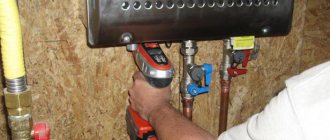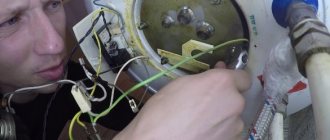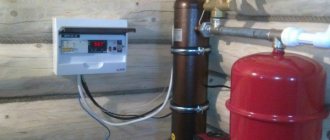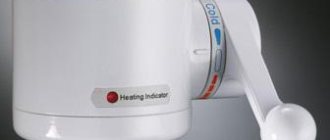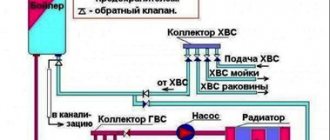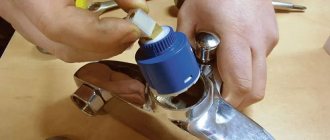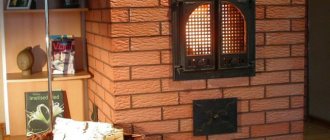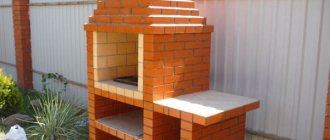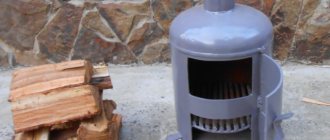People widely use self-contained structures to heat water. Such devices are ideal in conditions where there is no centralized water supply. They allow their owners to use hot water at any time of the day or night and not depend on utilities.
Until now, manufacturers have created many models of electronic boilers. However, not every person can afford to buy a device of this format. These people are advised to think about how to create a gas water heater with their own hands. Such a device can function perfectly on a stove with gaseous fuel. A dacha or private housing construction for temporary residence is an ideal place for the operation of such devices.
What is the basis of an electric heater?
A self-made instantaneous electric water heater operates on nichrome wire, which has a high level of resistance. It is wound on a ceramic frame.
The induction model works differently. A thick copper busbar is wound onto a metal pipe, then a voltage of 100 kilohertz is applied. The metal pipe is heated by an alternating magnetic field and heats the water.
Condensing boiler
To heat water, you can also use a gas or oil central heating boiler, preferably a condensing boiler. Condensing boilers, due to the specifics of their operation, consume less fuel, producing the same amount of heat as traditional boilers. Their efficiency is even several percent higher. Condensing boilers running on natural gas are considered the most economical; next on the list are boilers running on liquefied gas, closed by boilers running on liquid fuel. Condensing boilers are designed to emit few pollutants, so they pose no risk.
Heating a home consumes on average a few percent of the energy needed to heat it. By choosing the right device - easy to use, environmentally friendly, energy saving - you can save a lot.
What materials will be needed to create an electric flow heater?
How to make a instantaneous water heater with your own hands, powered by electricity? The process of assembling a tubular unit powered by a heating element will be described. In this case, a heating element with a thermostat for heating water has a power of 4 to 6 kW.
- a piece of steel pipe into which a heating element will fit with a small margin;
- two half-inch pieces of steel pipe, which have a standard thread on one end;
- pieces of steel in sheets, the thickness of which is 3 mm;
- nut and bolt for grounding;
- anti-corrosion paint.
Rating of quality kettles for stoves up to 3000 rubles
METROT Cooks 2.5 l
The kettle is made of steel with an enamel coating. It is resistant to mechanical stress. The device has a bright and colorful design that will create warmth and comfort in the home. This model is suitable for all types of slabs.
METROT has a comfortable plastic handle and a steel lid. The kettle spout with a whistle attachment will allow you to control the process of heating or boiling water. If necessary, the device can be washed in the dishwasher.
Advantages
- whistles loudly;
- Beautiful design;
- the possibility of purchasing kitchen utensils with a similar design;
- Can be washed in the dishwasher.
Flaws
- The spout can be removed without fixing.
Taller Kettle Gordon TR-1339 2.5 l
The kettle is made of high quality stainless steel. This ensures slow cooling of boiling water and durability of use. This model has a reliable handle fastening, which guarantees safe operation.
Taller TR-1339 has a matte finish. It gives the device a stylish design and makes cleaning easier. There is a convenient displacement mark on the outer surface. The kettle is equipped with a lid made of heat-resistant high-quality glass with a steel rim and a whistle that signals when the water is boiling. The capsule bottom with aluminum insert ensures even heat distribution.
Advantages
- suitable for all types of slabs;
- lasting;
- spacious tank;
- glass cover;
- retains heat for a long time.
Flaws
- The metal handle gets hot, so you can't handle it without an oven mitt.
Appetite - 4с209я
This inexpensive but high-quality kettle belongs to the universal category. Can be used in combination with slabs of any type. The design is classic. It vaguely resembles a Soviet stovetop kettle. Floral painting on white enamel is used as a decorative element. You can find several color variations on store shelves.
It is based on the use of rolled steel. Enamel is very easy to maintain. Vaguely reminiscent of stainless steel. Flame marks also do not remain on the body. Glass lid. Capacity – 3 liters.
Advantages
- high-quality case;
- compact dimensions;
- wear-resistant coating;
- classical performance;
- enamel coating.
Flaws
- There are enamel chips on the inside of the product;
- the full container will begin to boil away through the spout;
- The whistle is too loud.
Leonord - Sonne
A characteristic feature of this product is the presence of a monolithic handle that cannot be folded. The design looks stylish, which will allow you to store the kettle in a prominent place in the kitchen. The grip area does not get hot, based on numerous reviews online. Soft touch material is used as a protective and decorative coating.
A special button is provided to open the valve. The steel is coated with a protective varnish. This coating will not begin to peel off after years of active use. Capacity – 3.4 liters. An excellent solution for a large family that is used to drinking tea or coffee often.
Advantages
- stylish execution;
- protective covering;
- non-heating handle;
- Excellent value for money and quality;
- ergonomic shape.
Flaws
- incredibly noisy;
- permanent whistle.
Nadoba - Virga 731002
The shape of this design is stylish and very common. Suitable for heating water using any stove. The form factor is ergonomic. The handle is tight. A whistle is installed on the valve. Volume – 2.8 l. High quality stainless steel is used for production. It is based on the use of a three-layer bottom, which is made using capsule technology.
The heating rate is significant due to the high thermal conductivity coefficient. The structure is assembled in the Czech Republic. The build quality is not satisfactory. It is recommended to use an oven mitt when removing the kettle from the stove as the handle can become very hot. Volume – 2.8 l. Height – 230 mm.
Advantages
- thermally insulated handle;
- whistle;
- optimal dimensions;
- build quality;
- high thermal conductivity coefficient.
Flaws
- The handle may become hot.
Winner - WR-5044/WR-5045/WR-5046
This design falls into the ergonomic category. It should be noted that the device is compatible with all types of stoves. The body is painted in bright colors and looks incredibly attractive. It is based on the use of an all-metal multilayer bottom.
The handle is made of nylon. The coating is incredibly soft and pleasant to the touch. Even in a wet hand, the design will not slip out. The kit includes a non-removable whistle. The product can be cleaned either in the dishwasher or with running water. Volume – 4.5 l. A high-quality steel alloy is used to make the case. The lid is made of the same material.
Advantages
- suitable for all types of slabs;
- high-quality holder with soft coating;
- can be used in the dishwasher;
- multi-layer capsule bottom;
- build quality.
Flaws
- premature signs of corrosion.
Taller – Flecher TR-1383
This popular model is in deserved demand among compatriots, largely due to its versatility. Can be used in combination with any type of stove, including halogen. High-quality steel alloy is used for manufacturing.
The product is made in orange color. A convenient holder that cannot be folded deserves special attention. Due to the design features, it is recommended to store the product in the original box. Whistles loudly. Scale can be easily removed with a soapy cloth. Volume – 2 l.
Advantages
- numerous positive reviews;
- bakelite handles;
- ergonomic shape;
- stylish execution;
- whistle;
- heats up quickly.
Flaws
- Over the years, the paint begins to peel off.
Stages of work
- Before you begin assembling the electrical structure, you should clean all metal parts using a grinder.
- A metal piece is taken, the size of which is larger than the diameter of the pipe. Holes for installing the heating element are marked in its center. Depending on the model, it can have a power from 1 to 6 kW.
- The fasteners are removed from the heating element and the required drill is selected, which will be 1 mm larger than the device’s leg. This drill makes holes of the required diameter. Some models of heating elements contain a threaded or smooth body designed for insertion into some kind of device. Such a hole is cut using a drill or inverter. You can turn to a professional turner for help.
- If necessary, drill holes for mounting bolts and tap threads. A piece of metal is applied to the end of the pipe so that the holes are in the middle. The shape of the pipe is outlined.
- The metal is cut according to the markings using a grinder. Then another circle is made, only without holes.
- The heating element is fixed in the circle that is intended for it. Make sure that all parts fit snugly together.
- The heating element is removed and welded to the end of the pipe. It should be cut so that there is a distance of 2 cm from the end of the heating element to the second circle.
- Next, an indent of 1 cm is made from each end of the pipe, and a pair of holes are cut in it on the same line. They correspond to the diameter of the threaded sections located inside.
- Threaded sections are welded to the holes. Water will be connected to them.
- A circle with holes is welded under the heating element, and the heater is installed. Then a second circle is welded on the other side.
- A grounding nut is welded in any suitable place.
- The resulting structure is connected to the water supply and tap. This is how the device is checked for leaks. If a leak is detected, it must be repaired.
- The water heater is removed, its surface is degreased and covered with rust-resistant paint.
- After the paint has dried, you can install and connect the device.
Methods of heating water - tank
The water stored in the tank is heated using a coil, water jacket and/or electric heater. A simple conclusion is that there can be not only one heat source, but several at the same time. Such a tandem most often consists of a boiler (of any type) and solar collectors or a solid fuel boiler and an electric heater used outside the heating season. The advantage of the tank system is its versatility and even expandability. After all, we can buy a tank with two coils, use one first, and after a while connect collectors to it.
If we want to have a solar installation without a water tank, it will not work. And it is quite large, with a capacity of about 300 liters for 4 people.
In addition, we have a water supply that can be used at several points at once and in large quantities, limited by the size of the tank. This means you can quickly fill a large bathtub or use two showers at once, as well as wash dishes in the kitchen. In addition, the tank allows us to take advantage of the so-called circulation, i.e. circulating hot water in the pipes between the tank and the points of use, so that hot water comes out of the tap immediately after being turned on.
Tank capacity varies from 5 liters (for a washbasin) to 300 liters (for a whole house powered by solar energy). The general rule is 50 liters per inhabitant. However, this rule only works if the heat source is a simple coal or wood boiler - without a feeder or automation. If the boiler can turn on at any time and heat the water before it runs out, the volume can usually be less - about 120 liters for 4 people.
The most common solutions are ways to heat water in a tank. Then the heat source can be any, or even several.
Here's what you need to pay attention to - the tank must be large enough to fill the largest domestic hot water tank, the bathtub. However, there is an easy way to increase the amount of hot water if you know in advance that you will need it. Namely, you increase the temperature of the water in the tank and mix it with cold water at the points of use to 40-45°C.
Of course, storage systems are not without their drawbacks. However, they are generally not too annoying if designed correctly. First of all, you need to find a place for the tank, and not every home has a suitable utility room.
In addition, the reservoir capacity is limited. So if it's too small, the shower may cool it down and another family member will have to wait a while for the water to warm up. The power of the coil can be several kW, and a gas, oil or even coal boiler with a feeder can begin to heat the water even before it cools down. Electric heaters take time because they have low power (1.5-2 kW).
Heat loss from the storage tank and circulation pipes is also inevitable. Although this heat simply warms the house during the heating season, it persists into the second half of the year. Losses can be reduced with appropriate insulation, but in areas where we occasionally use hot water (such as an extra guest bathroom) or our lifestyle involves the house being empty many hours a day, constant on-demand heating may make more sense .
The tank takes up a lot of space, more than a boiler. Not every home has enough of it.
Manufacturing of a device operating from the heating system
How to make an instantaneous water heater with your own hands that operates from the heating system? The basis of operation of this unit is the heating of the heat exchanger by a coil, which is placed in the hot coolant of the heating system. A heat accumulator can play its role.
However, inserting such a coil into a new heat accumulator will lead to a bad result. You can cause damage to the insulation, which will dramatically reduce the level of efficiency. You should make your own heat accumulator. The device must be small in size. Then a heat exchanger is cut into it, and the entire structure is insulated.
Do-it-yourself drawings and calculation of an indirect heating boiler
Making the device with your own hands is based on the drawings drawn up. You will also have to carry out certain calculations of the system. But first you have to decide on the design parameters.
Required characteristics of the boiler for operation:
- Water consumption and storage tank dimensions;
- The position of the coil and its dimensions;
- Additional design elements - thermostat, heating element.
This data will help you decide on the design of the boiler. Taking them into account, a drawing of the future design is created. The optimal capacity for the tank and the material for constructing the boiler are also selected.
The volume of the tank is determined by calculating the daily water consumption. It is believed that each family member spends 50-80 liters of water per day. This amount will be enough for bath procedures, laundry, and washing dishes.
If hot liquid is used exclusively for household needs, a smaller water heater will be required. A 50-70 liter boiler will be enough. No need to purchase a larger tank unnecessarily. Precious heat is wasted on heating water, and this increases the cost of operating the device.
What will be needed for production?
To work you will need tools:
- Bulgarian;
- drill;
- inverter for welding;
- a soldering iron with a power of at least 300 watts;
- roulette;
- compass;
- core;
- metal cutting scissors or pruning shears;
- device for rivets.
The following materials should be prepared:
- a copper tube made of copper, the diameter of which is 4-8 mm;
- You will definitely need sheet steel (3 mm);
- a round mandrel made of metal or wood with a diameter of 10-12 cm;
- sheet iron 5 mm thick;
- anti-corrosion paint;
- two 90 degree squares from half-inch pipe;
- four pieces of half-inch pipe, 10-15 cm long, with a standard thread type;
- two half-inch threaded brass couplings;
- a half-inch stainless steel pipe with a diameter of more than 20 cm (part of a gas cylinder is also used);
- medium-temperature copper and brass solder and corresponding flux;
- PTFE sealing material.
For insulation you should prepare:
- mineral wool;
- steel corner with shelf measuring 50 mm;
- iron in sheets 1 mm thick;
- rivets.
The construction pricing reform should have been completed 1065 days ago.
Good afternoon In the standards of the GESN-2001 collection No. 12 “Roofs” 12-01-002-08, 09, 10 propane gas consumption is 11.8; 6.9; 3.4 kg accordingly are indicated erroneously. The most commonly used burners have an average propane consumption of 6 kg/hour. Based on this, propane consumption (code 542-0042) should be taken at the specified standards in the following amounts: standard GESN-12-01-002-08 - 41.4 kg, 09 - 27.6 kg, 10 - 14.4 kg. QUESTION: is there official confirmation of these figures?
6 kg/hour - what kind of consumption is this, where did it come from? According to the passport or something? Excuse me, have you ever been on a roof or waved a torch? I was and waved a lot... The operating mode in the summer is this: 30% at idle (while you are preparing the next roll, cutting it, trying it on, moving on) and with connections - all 50%. In winter, however, the consumption increases sharply - 1.5 or 2 times (you have to warm and dry the base and warm the freezing cylinders). Try to negotiate with the Customer for compensation for gas, but in practice, during roofing work, the cost of gas is a small part of the cost of the work, so you shouldn’t push too hard.
The customer, as a rule, agrees, and then the switchgear comes and says: “Who are you to add gas to the state price?” That's how it was for me. And I read about such an expense in Grand Stroy-Info in the “Consultations and Explanations” magazine. It was all written there, however, without reference to an official source. So I’m wondering how the inspectors will react to this?
And there is no official source. Even in the standard database, propane butane costs are left unchanged. So refer to “Consultations and Clarifications” No. 2-2004, pp. 12-13.
Manufacturing process
- A copper tube should be wound around the mandrel. If its diameter is less than 8 mm, then we recommend making a double winding. The length of the spiral should be 15-20 cm. The tube should be pulled towards you to prevent its deformation. A mandrel with a diameter smaller than 5 mm should not be used. This will cause the tube to bend and flatten.
- You need to cut a couple of round plates from sheet copper. Their diameter should be the same as that of brass couplings. Holes are drilled in the center of the plates according to the diameter and number of tubes. Both surfaces of the plates and one of the ends of the coupling are cleaned. This is done using sandpaper.
- Medium-temperature solder should be used to solder the plates to the couplings.
- After the parts have cooled, tubes are inserted into them to a depth of 1 mm. They are soldered using a gas burner or the same solder with flux.
- Next, the coil is connected to the water supply and water is supplied to check for leaks. If it exists, the problem must be fixed.
- In a thick pipe it is necessary to mark a pair of holes that correspond to the coil couplings. They must be drilled so that they are 1 mm larger than the diameter of the pipe sections.
- The stainless steel pipe is cleaned from the inside and outside using a grinder. A coil is lowered into a thick pipe. It is inserted into the hole of the tube with the coil using FUM tape. Then the coupling is screwed in.
- Thin pipes are soldered using a torch or fluxed solder. The thin tube should not be overheated so as not to subject the FUM tape to melting.
- A pair of holes are drilled from the opposite edge of the body, and threaded pipes are welded to them.
- If the heating system has thick pipes, then threaded sections of identical diameter should be used and a hole made to match their size.
- A pair of circles are cut out of sheet steel, the diameter of which should be 11 cm larger than the body. If the water heater is not insulated, then the size of the disks should match the diameter of the body.
- The circles are welded to both ends of the body.
- Both heating terminals are connected to the water supply to check the device for leaks.
- The unit should be coated with paint that prevents corrosion.
How to choose a geyser
The purchase of instantaneous water heaters is made taking into account the needs of the user - the volume of hot water consumed, the composition of the family, the number of water intake points. The right choice will ensure comfort in using the equipment and significantly extend its service life. When studying our official website of geysers, we recommend paying attention to the following criteria:
- Performance - small-capacity models up to 13 l/min are suitable for installation in apartments; more productive options will be ideal for private homes or small commercial establishments (for example, a bar or cafe).
- Water intake points - if you plan to use hot water only for washing dishes in the kitchen, it is enough to choose a model designed for one water intake point. When using a shower or bath, it is better to give preference to multi-point heaters.
- Type of ignition - can be automatic, with water heating when the tap is opened, or on piezoelectric elements that require a preliminary press of a button.
In addition, geysers on our official website may have electronic or mechanical control, vary in size and the presence of additional functions. Taking these characteristics into account will help you choose the optimal solution specifically for your premises.
Water heater insulation
- 7-10 angles are welded to the surface of the body so that the second shelf runs parallel to the surface of the pipe. Welding is not carried out with a continuous seam, but through four tacks, the length of which is 1 cm.
- A strip 2 cm wider than the distance between the end circles of the base is cut out of thin sheet material. The length of the strip should be enough to wrap the device.
- Sides are made on both sides of the strip, the width of which is 1 cm. Using pruning shears or scissors for cutting metal, the sides are given a sawtooth shape. The teeth are marked with a zigzag. They should have the shape of an equilateral triangle. The teeth on the edge of the strip, which are opposite the corner, are cut off.
- The strip is applied to the corner. It must be directed in the correct direction to wrap the unit. Once the rivets are installed, it will be impossible to correct errors in operation.
- Next you should drill the strip and corner. Seven holes should be made and the parts should be fastened using a riveting device.
- A piece of the required size is cut out of mineral wool and inserted between the corner to which the thin metal is attached and the adjacent corner.
- The insulation is covered with metal and secured with rivets.
- A similar operation is carried out with other corners.
What materials will be needed?
The following materials should be prepared:
- a block of wood with a cross section of 5x5 cm;
- plywood sheet 20 mm thick;
- board 10 cm wide and 5 cm thick;
- rubber watering hose;
- foil-based insulation;
- self-tapping screws of various sizes;
- glass 3-5 mm thick;
- plywood 3-5 mm thick;
- wooden slats 5 cm wide and 1 cm thick;
- knitting wire.
The basis of such a heater is a rubber hose.
Manufacturing instructions
- A rectangular base is cut out of plywood. The bars are screwed to it around the perimeter. They connect with each other. This way the structure will be more durable.
- The resulting box is lined with foil-based insulation from the inside. The foil is laid out.
- Pieces 15 cm long are cut from the board. They will act as guides for the hose. One edge should have a semicircle shape. The diameter of the circle should be the same as the width of the board.
- The guides are screwed to the plywood from the insulation side so that the hose laid on them forms a snake. Where the hose turns, the distance between the turns should not be larger than its diameter.
- In the block located below, a pair of grooves for entry and exit are cut using a jigsaw.
- Four strips are cut from plywood, the width of which is 4 cm.
- Plywood strips are attached to the front surface of the bars so that they form the shape of a step that fixes the position of the glass.
- The water heater rises to the roof and is attached to the south side. We recommend horizontal installation. So the efficiency of the device will be higher.
- The hose should be laid along the guides and secured with loops of binding wire. They are attached to the plywood. The hinges should not be located above the guides, as the glass may crack.
What can be used instead of a rubber hose?
Instead of a rubber hose, a steel tube can be used, the thickness of which is 5-10 mm, or a coil from an old refrigerator. In this case, guides will not be needed, but you will have to bend the pipes in such a way as to achieve a turning radius of at least five diameters.
After the tube has been given the appropriate shape, it is covered with a tin sheet painted black and secured in the device body.
The glass is cut to size and mounted into the unit using slats that are laid on the beam. Water is connected to the water heater.
Do-it-yourself coil for a boiler
For the heat exchanger, a copper or brass tube is used. The diameter of the pipe can be from 8 to 20 mm. At the same time, a calculation is made of the pipe molding so that there is enough power to heat the tank.
Data for calculation:
- Diameter (the parameter is taken in meters);
- Fluid temperature in the heating system;
- Temperature indicators of tap water.
To determine the length of the heat exchanger, a special formula is used. In this case, the thermal power is divided by the number Pi, then multiplied by the diameter and by the temperature difference between the heating and water supply. It is better to round the obtained data and take the pipe with a margin.
To give the heat exchanger a spiral shape, the pipe is wound onto a blank. The diameter of the coil must correspond to the diameter of the tank. A small distance is provided between the spirals. The end of the coil is equipped with fittings. Before welding the system, its functionality is checked.
Warning
When making an instantaneous water heater with your own hands, you must clearly understand that only you are responsible for diagnosing and checking the device for malfunctions. When assembling the unit, you should be extremely careful. Incorrect assembly can lead to unpredictable consequences.
Before the first start-up and every three months, we recommend checking the condition of the wires, contacts and welding seams.
Before turning on the heating element, do not forget to supply water. Otherwise, the liquid in the device will begin to boil, and the electric tube-based heater will fail.
Methods of heating water - protection against scalding
Hot water should be safe and comfortable to use. To do this, its temperature should be neither too low (inconvenient) nor too high (risk of scalding). The problem of too high temperatures concerns installations with solar collectors and solid fuel boilers without automation. Both of these heat sources are somewhat uncontrollable and can cause the water temperature to rise significantly.
However, this problem is easily solved by installing a thermostatic mixing valve at the outlet of the tank. If the water temperature in the tank does not exceed the set value, for example 45°C, only hot water will flow through the valve. If it is higher, the valve will mix it with cold, so that when it enters the tap, its temperature will be 45°C. Thermostatic taps work on the same principle, but more of them are needed, which means significant costs.
The system is a little more complicated if you want to have circulation, but it's not a big problem. Let us show in the drawing what the arrangement of connections should look like. Please note that in this way it is also possible to connect the circulation circuit to the tank without an additional circulation connection.
The thermostatic mixing valve protects against burns if the water in the tank is too hot. It should be a mandatory accessory in installations with solar collectors.
